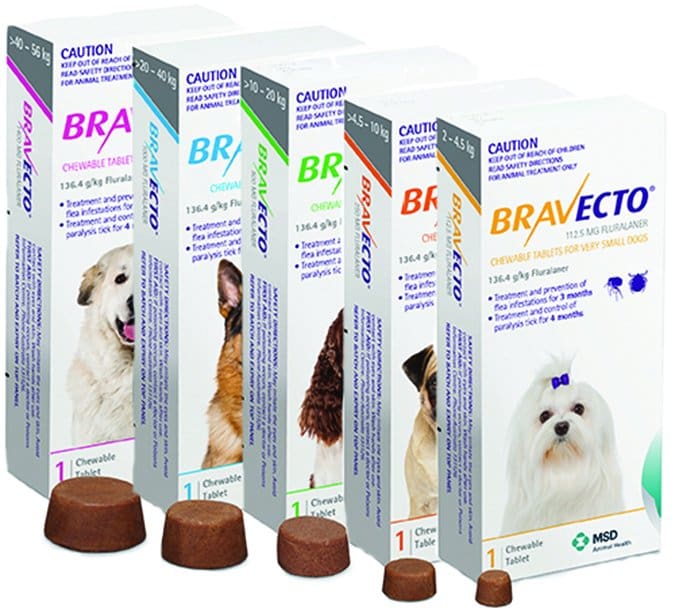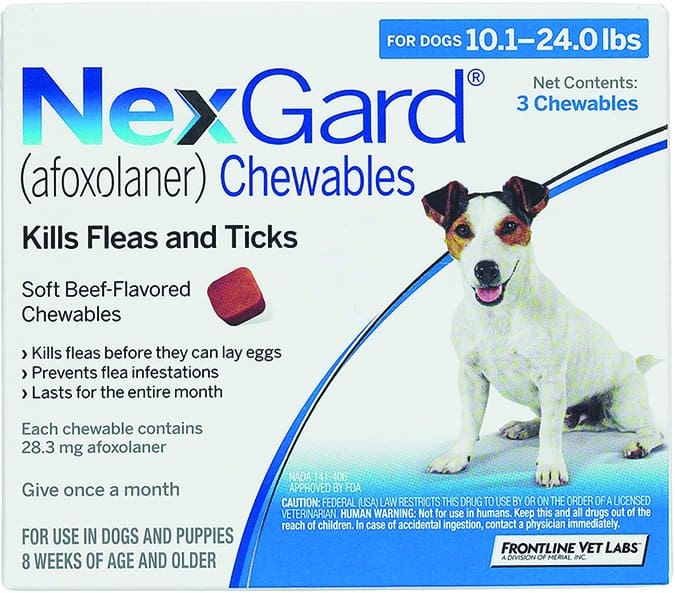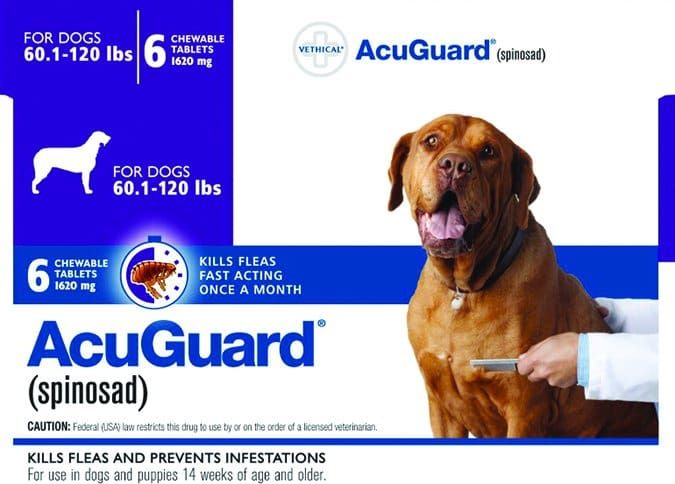Note: The following article was originally published in the September 2017 issue of Whole Dog Journal. We have updated it following the FDA’s September 20, 2018 release of a communication regarding the medications described in this article.
Dogs and dog owners have suffered from flea bites for all of their shared history, but in the past 20 years or so, scientists have been developing more and better tools that modern dog owners can use to defeat fleas. The development of these products has always been a balancing act – the goal is to find the most effective flea killers that cause the least amount of harm to the dog, her family, and the environment at large.
To help dog owners understand the flea-control options that are available to them, we have published a number of articles describing how various types of flea-control products work. These include the products described in this article, oral medications that kill fleas and that are available by veterinary prescription only, as well as the following:
- Topical pesticides that are meant to be applied monthly (February 2002).
- Over-the-counter oral flea-killing medications (October 2017).
- How to clean your home and use “insect growth regulators” to interrupt the flea’s life cycle (December 2017).
- How to best manage the war on fleas in your home safely and effectively (January 2014).
Why Use Prescription-Only Oral Medications?
For several reasons, many veterinarians tend to put the most stock in prescription-only oral medications (at least, until recently; we will see what develops in light of the September 2018 FDA communication regarding these drugs and their potential for causing seizures in dogs and cats). In fact, these products are highly effective solutions for killing fleas – but they do pose significant potential side effects.
In our opinion, oral flea control medication should be reserved for dogs who have severe flea allergy, live in an area where fleas are a constant threat, who suffer serious adverse reactions to topical flea-killing pesticides, and who have taken these oral products previously without any adverse reactions. And at most, they should represent only a partof a dog owner’s efforts to control fleas.

Why would a veterinarian recommend such products? Well, take the case of the Great Dane I fostered in the summer of 2016, who had an incredibly thin coat and who was very itchy. When I took her to a veterinarian for a complete examination and discussion of what we could do for her itching, the vet essentially refused to consider any sort of allergy diagnosis or treatment until the dog had been on an oral flea-prevention medication for a minimum of three months.
She said, that in her opinion and experience, “only longer-term oral medications offer enough protection from fleas to rule out an allergy to fleas as the cause of persistent itching.” To that end, she prescribed a medication called Bravecto, a drug that can kill any fleas that bite the dog for as long as 12 weeks after the dog is dosed.
I countered that I could repeat topical insecticides at regular intervals. But the veterinarian was firm in her belief that only a dose of Bravecto would ensure that there would be no gap in flea prevention for long enough to ensure that the Dane’s itching was not caused by fleas.
Merck, the maker of Bravecto, strongly promotes this point, taking slightly different tacks on its product website pages for owners and veterinarians. Owners are told that Bravecto makes flea control easy: “With Bravecto Chew, dogs get 12 weeks of flea and tick protection with a single treatment. That’s nearly three times longer than monthly treatments. This makes it easy for you to provide long-lasting coverage to your dog, without having to worry about remembering frequent treatments.”

On Merck’s pages for veterinarians, the most-promoted benefit is owner compliance: “Convenient long-lasting protection means less chance of noncompliance,” it says on one page. “Bravecto makes all the difference in improving pet-owner compliance,” it says on another.
Edible Flea Control VS. Topical
There are a number of other advantages to using an oral flea-control product over a topical product:
– If you or your children pet the dog, you may prefer not to have contact with a topical product. This could also be true in a multi-pet household where pets groom each other.
– Dogs with longer coats often sport a “greasy spot” for several days after topicals have been applied, increasing the concern of petting the dog and coming into contact with the pesticide.
– Owners of dogs with skin problems, or who have had a reaction in the past to any sort of topical product, might prefer to use an oral one.
– Bathing or even swimming too soon after application may reduce the effectiveness of topicals.
– Some ingredients used to kill ticks, such as permethrin (used in K9 Advantix and other products) and amitraz (used in Certifect and the Preventic collar), are toxic to cats, which can be a problem in a household that includes both, especially if they are friendly with each other. In that case, giving the dog an oral product would be safer for the cat.
– Because the insecticides in the newer oral products haven’t been used for very long, they can be more effective in areas where fleas and ticks may have built up some resistance to the older topical products.
– Last but not least, oral flea-control medications have been proven to be more effective than topical pesticides in both killing fleas and helping to control a household infestation more quickly.
Disadvantages of Oral Flea-Killing Medications
Every product you feed or use on your dog poses some amount of risk, and some percentage of dogs will react badly to any product.
The most significant disadvantage of these medications is that, once a dog digests one, it’s in his system for as long as it’s designed to be. If he has an adverse reaction, veterinary attention may be required to treat his symptoms, but there is little that can be done to mitigate or halt the overall reaction. In contrast, if a dog has an adverse reaction to a topical pesticide, his owner can immediately bathe him to reduce the adverse effects. The effects of an oral medication can’t be mitigated in this way.
Dog deaths and seizures have been reported from the use of these products. The product manufacturers (and, until recently, the FDA) have indicated that these most serious adverse effects are very rare – not numerous enough to be listed among the most common adverse side effects on the package inserts. We are awaiting updated information regarding the adverse drug experience (ADE) reports that have been collected by the FDA since the introduction of these products to the market.
The most common adverse side effects of oral flea-control medication are stomach upset and vomiting. The very fact that a dog can vomit up the medication – and the possibility that he might do so without you being aware of this – is a fairly significant disadvantage, too. If you don’t find the vomit, you may think the product was just plain ineffective. And then there is the possibility the vomit is discovered and eaten by another one of your dogs!
It should also be noted that while all of these products are formulated with palatants to entice a dog to chew them up and eat them, some dogs may refuse. In this case, you will be forced to either sneak the medication into the dog’s food or give it to him like any other pill – and you’d have to break the larger doses for large dogs into pieces to “pill” them.
Finally, but not insignificantly, prescription oral flea-killing medications can compromise the integrity of a necessarily strict food-allergy trial.
Isoxazolines: The Newest Class of Flea-Killing Drugs
There are not that many medications approved by the FDA for controlling fleas on dogs. Most products contain one significant “active ingredient” that controls fleas, although a few contain more than one.
The newest class of insecticides are isoxazolines, chemicals that are selectively toxic to insects (fleas) and acarines (mites and ticks) in a way that is not supposed to pose a risk to mammals. Isoxazolines kill fleas and ticks by inhibiting their ligand-gated chloride channels, in particular, those gated by the GABA neurotransmitter. This blocks pre- and post-synaptic transfer of chloride ions across cell membranes, resulting in uncontrolled activity of the fleas’ and ticks’ central nervous system (CNS) and death.
In plain English? The operation of many physiological processes rely on ion channels, chemical pathways where charged ions from dissolved salts (including sodium, potassium, calcium, and chloride) pass through otherwise impermeable cell membranes. Most of these channels are gated, opening and closing in response to certain stimuli. Isoxazolines close the chemical gates on chloride channels that are essential for the CNS of fleas and ticks, resulting in their death.
What follows is a description of each of the isoxazoline-containing products and information from their product inserts.
Keep in mind as you read that, as stated earlier, WDJ recommends the use of these products only under certain circumstances (specified above), for a limited amount of time. The information is presented so that owners understand what these products are, how they work, and how they differ from each other.
Bravecto
The active ingredient in Bravecto, a product introduced by Merck Animal Health in early 2014, is an isoxazoline chemical called fluralaner. It is given once every three months. Each Bravecto treatment kills fleas and certain species of ticks (black-legged tick, American dog tick, and brown dog tick) for 12 weeks, three times longer than any other oral flea treatment. It kills the lone star tick for eight weeks. It also kills the mite responsible for demodectic mange, though it has not yet received FDA approval for this use. Studies indicate that Bravecto kills more than 98 percent of fleas, and 100 percent of ticks, in less than 12 hours after administration.
Bravecto should be administered with food to maximize the bioavailability of the active ingredient.
The most common adverse reactions recorded in clinical trials were vomiting, decreased appetite, diarrhea, lethargy, polydipsia (excessive drinking), and flatulence.
Although its maker offers no specific warning about this in its product literature, Bravecto should be used with caution in dogs with a history of seizures, similar to other drugs in this class.
Bravecto is said to be safe for pregnant, breeding, and lactating dogs, dogs weighing at least 4.4 pounds, and for puppies who are at least six months old (and 4.4 pounds). No adverse reactions were observed in pre-approval studies when Bravecto was used concurrently with other medications such as vaccines, de-wormers, antibiotics, and steroids.
Credelio
This is the most recently introduced oral flea-killing medication to the market; Credelio, made by Elanco, was approved for use in January 2018. Its active ingredient is an isoxazoline chemical called lotilaner. It is given once a month. Credelio kills fleas, the Lone Star tick, American dog tick, black-legged tick, and brown dog tick.
Studies indicate Credelio begins to kill fleas within four hours of administration, and is 100 percent effective against fleas within 24 hours. It is 97 percent effective against ticks within 48 hours.
Due to reduced drug bioavailability in the fasted state, Credelio must be administered with a meal or within 30 minutes after feeding.
The most common adverse reactions recorded in clinical trial were weight loss, elevated blood urea nitrogen (BUN), polyuria (excessive production of dilute urine), and diarrhea.
Credelio is said to be safe for dogs and puppies who weigh a minimum of 4.4 pounds and who are eight weeks of age or older. No adverse reactions were observed from the concomitant use of Credelio with vaccines, anthelmintics (dewormers), antibiotics, steroids, NSAIDS, anesthetics, or antihistamines. The safe use of Credelio in breeding, pregnant or lactating dogs has not been evaluated. Use with caution in dogs with a history of seizures.
NexGard
The active ingredient in NexGard, a product introduced by Frontline Vet Labs, a division of Merial, Inc., in 2013, is an isoxazoline chemical called afoxolaner. It is given once a month. Each NexGard treatment kills fleas and the black-legged tick, American dog tick, Lone Star tick, and brown dog tick. It also kills the mite responsible for demodectic mange, though it has not yet received FDA approval for this use.

In July 2018, Nexgard was approved by the FDA for the prevention of the infection that causes Lyme disease in dogs. Lyme disease is caused by a bacterium, Borrelia burgdorferi (B. burgdorferi), that is carried by certain species of ticks. The data presented by Merial in the supplemental application measured the transmission of B. burgdorferi to dogs after exposure to infected Ixodes scapularis ticks, and demonstrated that transmission was prevented as a direct result of killing the ticks. The study did not measure whether the product affected rates of illness from Lyme disease in dogs.
Studies indicate NexGard was 100 percent effective against fleas within 24 hours, and more than 97 percent effective against American dog ticks and Lone Star ticks, 94 percent effective against black-legged ticks, and 93 percent effective against brown dog ticks.
NexGard can be given with food or on an empty stomach.
The most common adverse reactions recorded in clinical trials were vomiting, itching, diarrhea, lethargy, and lack of appetite.
Nexgard is said to be safe for dogs and puppies who weigh four pounds or more and who are at least eight weeks of age. No adverse reactions were observed in preapproval studies when NexGard was used concomitantly with other medications, such as vaccines, dewormers, antibiotics, steroids, NSAIDS, anesthetics, and antihistamines. The safe use of NexGard in pregnant, breeding, or lactating dogs has not been evaluated. Use with caution in dogs with a history of seizures.
Simparica
The active ingredient in Simparica, a product introduced by Zoetis in 2016, is an isoxazoline chemical called sarolaner. It is given once every month. Each Simparica treatment kills fleas (100 percent within 24 hours) and certain species of ticks (almost 97 percent of Lone Star tick, Gulf Coast tick, American dog tick, black-legged tick, and brown dog tick) for one month.
Simparica also kills the mites responsible for demodectic mange (demodex), sarcoptic mange (scabies), and otodectic mange (ear mites), though it has not yet received FDA approval for these uses. (We’ve seen reports from veterinarians who are using it for this off-label use with success.) Its claim to fame is its speed; Zoetis claims that Simparica starts killing fleas within three hours and ticks within eight hours of administration.
Simparica may be administered with or without food.
Simparica may cause abnormal neurologic signs such as tremors, unsteadiness, and/or seizures. Simparica has not been evaluated in dogs who are pregnant, breeding, or lactating. Simparica has been safely used in dogs treated with commonly prescribed vaccines, parasiticides and other medications. The most frequently reported adverse reactions were vomiting and diarrhea.
Simparica is said to be safe for dogs weighing at least 2.8 pounds, and for puppies who are at least six months old (and 2.8 pounds).
Next Flea Medication Class: Spinosyns
This class of chemicals does not kill ticks, only fleas. Spinosyns work in a similar fashion as the isoxazolines, in that they activate reactions in the flea’s cellular ion channels (in this case, the nicotinic acetylcholine receptors or nAChRs), causing a fatal CNS reaction in the fleas. Insects treated with spinosyns show involuntary muscle contractions and tremors resulting from activation of motor neurons. Prolonged spinosad-induced hyperexcitation results in prostration, paralysis, and flea death. The selective toxicity of spinosad between insects and vertebrates may be conferred by the differential sensitivity of the insect versus vertebrate nAChRs.
The prescription oral flea-killing products in this class of medications all utilize a spinosyn called spinosad.
Comfortis/AcuGuard
These products are the same thing; Elanco makes AcuGuard for the VCA chain of veterinary hospitals under the Vethical brand.
As previously mentioned, the active ingredient in Comfortis and AcuGuard is spinosad. These products were FDA-approved in 2007. They are given once every month. Each treatment kills fleas for one month. Flea count reductions of 97.9 percent were observed one month after the first treatment and 99.9 percent after three monthly treatments with Comfortis or AcuGuard.
Administer these products with food for maximum effectiveness.
The most common adverse reaction reported from Comfortis/AcuGuard is vomiting. Other adverse reactions reported in decreasing order of frequency are: depression/lethargy, decreased appetite (anorexia), incoordination (ataxia), diarrhea, itching (pruritis), trembling, excessive salivation, and seizures.
Following concomitant extra-label use of ivermectin (very high doses used to treat mange) with Comfortis/AcuGuard, some dogs have experienced the following clinical signs: trembling/twitching, salivation/drooling, seizures, incoordination (ataxia), excessive dilation of pupils (mydriasis), blindness, and disorientation. Products containing spinosad should be safe when used along with the normal heartworm preventive dosage of ivermectin or milbemycin oxime, but use with caution in dogs who have or may have the MDR1 mutation that causes sensitivity to certain drugs.
Neither should these products be combined with high doses of milbemycim oxime (Interceptor, Sentinel), used to treat demodectic and sarcoptic mange, as this combination can cause serious adverse neurological effects.
While Elanco says these products can be combined with other flea and tick products, we wouldn’t recommend it. Nor should Comfortis/NexGuard be used for dogs with epilepsy or other seizure disorders.
Use with caution in breeding females. The safe use of Comfortis/AcuGuard in breeding males has not been evaluated.
Comfortis/AcuGuard is approved for use in dogs 14 weeks of age or older and 3.3 pounds of body weight or greater.
Trifexis/ComboGuard
These products are the same thing; Elanco makes ComboGuard for the VCA chain of veterinary hospitals under the Vethical brand.
Trifexis and ComboGuard combine spinosad with milbemycin oxime, a chemical that is used as a heartworm-preventive and is effective against intestinal parasites (hookworms, roundworms, and whipworms).
Trifexis/ComboGuard is approved for use in dogs and puppies eight weeks of age or older and five pounds of body weight or greater.
Administer these medications with food for maximum effectiveness.
Treatment with fewer than three monthly doses after the last exposure to mosquitoes may not provide complete heartworm prevention. Prior to administration of Trifexis/ComboGuard, dogs should be tested for existing heartworm infection. Use with caution in breeding females. The safe use of these medications in breeding males has not been evaluated.
Use with caution in dogs with pre-existing epilepsy.
What Elanco calls “mild, transient hypersensitivity reactions manifested as labored respiration, vomiting, salivation, and lethargy” have been noted in some dogs treated with milbemycin oxime carrying a high number of circulating heartworm microfilariae. These reactions are presumably caused by release of protein from dead or dying microfilariae. Milbemycin oxime is more effective against microfilariae than most other heartworm prevention medications (including ivermection) and may therefore cause anaphylaxsis if given to a heartworm-positive dog.
Just as with Comfortis and AcuGuard, following concomitant extra-label use of ivermectin with spinosad, some dogs have experienced the following clinical signs: trembling/twitching, salivation/drooling, seizures, incoordination (ataxia), excessive dilation of pupils (mydriasis), blindness and disorientation. Spinosad alone has been shown to be safe when administered concurrently with heartworm preventatives at label directions.
Again, products containing spinosad should be safe when used along with the normal heartworm preventive dosage of ivermectin or milbemycin oxime, but use with caution in dogs who have or may have the MDR1 mutation that causes sensitivity to certain drugs.
The most common adverse reactions reported are vomiting, depression/lethargy, itching (pruritic), decreased appetite (anorexia), diarrhea, trembling/shaking, ataxia, seizures, hypersalivation, and skin reddening. Puppies less than 14 weeks of age may experience a higher rate of vomiting.
Tips for Medication Use
It bears repeating: We do not recommend the use of these prescription-only flea-killing medications. However, if your dog is highly allergic to fleas, you live in an area where fleas are a chronic threat, your dog suffers from adverse reactions to topical pesticides, and he has not reacted to these medications in the past, use the products with these safety tips in mind:
1. Read all medication directions before giving to your dog.
Always read the instructions for use carefully before administering to your dog, especially the cautions and contraindications. It’s always shocking when we hear that someone gave their dog a medication without reading the instructions – and often refusing to take responsibility. “My veterinarian prescribed it! How was I supposed to know it could make my dog sick?” While it’s true that a veterinarian should inform her clients about the contraindications of any product she recommends, in reality, few vets have or take the time. If you read something in the product insert’s cautions and contraindications that seems like it would apply to your dog and concerns you, call your veterinary hospital and ask for the vet to call you back to discuss it – again, before you give the product to your dog.
2. Pay attention to the instructions.
Always follow the directions carefully. Products for cats and dogs are not interchangeable; a number of products for dogs are potentially fatal for cats. Topical products should not be ingested. Pay special attention to weight and age minimums for safe use, as well as the cautions regarding administration to sick, weak, old, medicated, pregnant, or nursing dogs.
3. Observe your dog carefully after administering a flea-control medication.
Most adverse reactions happen within a few hours. Contact your veterinarian with a speed that is congruent with the seriousness of your dog’s symptoms. (Serious? Go the to veterinary ER! Mild? Call your vet the next day to report and ask the staff to note this in your dog’s chart.)
4. Start a flea control calendar.
Keep track of when you administer a flea-control product to your dog. It’s advisable to write the date, time, product, and dosage on a calendar that you can easily refer to if your dog has an adverse reaction and you need to recount details to your veterinarian. Also note any abnormalities you may notice in your dog’s health, appetite, digestion, and demeanor after administration.
Nancy Kerns is the editor of WDJ.







My dog has been on Trifexis and nothing else. She always has a high liver numbers. Should i try something else. We have never had a free problem. Is topical safer. Thank you
It fails the common sense test that a systemic toxin that kills parasites will not have long term systemic consequences for the dog. We have opted for natural topical sprays but more importantly an inch by inch check of our dog several times a day to look for ticks. It is worth the effort.
I need to know if there is anything I can do to help my miniature poodle. I gave her Nexgard 2 and 1/2 weeks ago for the first time. She has been sick ever since, not eating, no appetite, throwing up. We have had her at the vets for IV fluids. She is such a sick girl.
Not a vet here, but sons dog almost died. IV fluids and vet recommended Milk Thistle for trashed liver . He is still on special foods two years later but always milk thistle.
Good luck!!
Does anyone know whether the prescription oral medication can be toxic for a cat within days of ingestion if the cat is licking the dog’s fur? Our 7 year old cat developed breathing problems and other issues within days of licking the dogs face and neck about two days after we gave him his medication. The vet cannot entirely figure out what’s wrong with the cat. He’s still having breathing trouble although it’s somewhat better.
Our dog died from Nexgard. Please visit and join the Facebook group “ Are Bravecto, Nexgard,Simparica and Credelio Killing Our Dogs?”. You will find hundreds of dog owners who have lost their dogs to these products. Thousands that have had permanent neurological damage. The fb group is global as there are victims in almost every country.
No surprise when consulting with our vet practice that I was encourage to turn my pup into a flea vacuum by giving her one of these products…No way. My life is too complicated with caregiving for elder parents to even think of risking my loves well-being to these chemicals. Looking for non toxic ways…Did call exterminator and their stuff is too toxic to walk on when wet and they want the house cleared even of the exterminator for 2-4 hours….
yesterday Our puppy was put on Credelio and she had her first seizure within hours of administrating, her second seizure 2 hours after that and she has 3 today.
How long does the toxins stay in her little body?
Jeannette, I believe from what I read about this is it stays in the body for which it was intended for an so if it a 30 day intervention it stays for that length of time.
Please do not take a chance with your poor dog’s life. These toxins build up in their body. If an adverse reaction doesn’t happen right away, it can over time. Join the facebook group Bravecto Simparica killing our Dogs. You won’t believe all of the stories from people whose dogs were dangerously affected by these drugs and even killed.
My Morkie was put on NexGard, after being on Trifexis, and Revolution. In her sleep at night (usually) she was having movements, change in breathing and not being responsive initially. Recently the Veterinarian told me she was probably having seizures. I decided to stop the NexGard and she hasn’t had a seizure since. She is an indoor dog and goes on dog pads in the house. What should I use now?
My
My vet gave us a flea pill and we gave it to her yesterday and ever since she’s been sleeping and I think she has a fever and she isn’t eating or drinking anything and I don’t know what’s wrong with her
Many products are available for prevention and control of flea and tick infestations. You can discuss all options with your veterinarian to choose the right product for your pet. Bravecto, Credelio, Nexgard and Simparica prior to approval, and these products continue to be safe and effective for dogs. you can read current popular flea & ticks products at Budgetpetcare.
these dogs become part of our family, I have heard hundreds of stories where people have lost their pets from these medications, why are veterinarians still given these toxic meds to our best friends if there is any chance of an adverse reaction? it’s like playing chicken with their lives. To watch your pet go through these seizures is horrifying and to have them die is unbearable. Please think twice before giving these poisons.